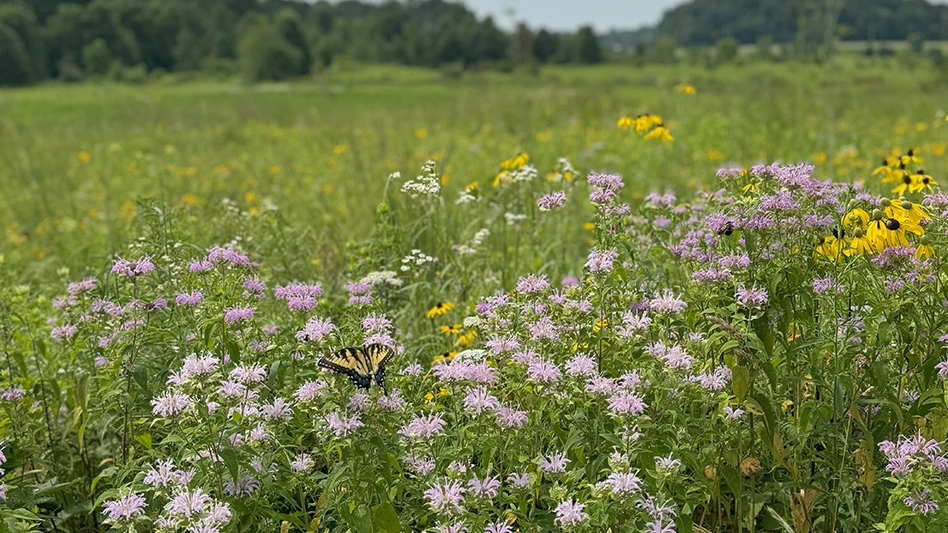
Bayer
Greetings from Elkhorn, Nebraska. Haven’t heard of the growing municipality 25 miles west of an increasingly prosperous Midwest city?
Let’s turn to somebody proficient in maintaining pure playing surfaces for the masses. The Club at Indian Creek director of agronomy Jim Nedrow settled in suburban Omaha in 2005.
“When I moved to Omaha, Elkhorn was a little bit of a drive from what you would consider the main part of Omaha,” he says. “Elkhorn and Omaha have basically become one. We are on the western edge of the Omaha metro area. It’s unique because everything is moving toward us.”
When Nedrow says everything, he means every imaginable Midwest convenience. “There’s a Hy-Vee going in,” Nedrow says in a Chamber of Commerce moment, “which is a big deal for Elkhorn.”
Omaha golfers shopping for a place to spend time and whatever money remains following non-discretionary purchases such as groceries flock to where Nedrow works. Indian Creek owners Bill and Brett Gottsch decided a decade ago to turn Indian Creek, a 27-hole facility with surprising elevation change, into a showpiece for a company whose holdings include numerous feed yards and ranches. The transformation occurred without straying from the greater purpose of offering quality and affordable golf to Nebraskans and visitors.
Even during peak play periods, green fees are less than $65. Indian Creek hosts a PGA Tour-sanctioned event, the Korn Ferry Tour’s Pinnacle Bank Championship, leaving an outsider to wonder how a course can provide tournament-caliber conditions and remain accessible to most customers.
Quality and quantity – Indian Creek averages around 40,000 rounds annually – coexist when talented, determined and prideful people receive and maximize ample resources, including personnel. The department Nedrow leads includes superintendent Shawn Tordrup and assistants Adam Dredge and Jeff Moeller. Equipment technician Tim Soppe and veteran full-timer Rich Lee are also key parts of Indian Creek’s agronomic nucleus.
The department’s objective is straightforward in definition, yet complex in execution: keeping T-1 bentgrass greens and ryegrass fairways and tees in elite condition despite unpredictable weather and abundant play. Challenges are exacerbated on weekends as tee times begin at 6:30 a.m. and 300 players roam the three nines before noon.
Summers in Omaha, where the Missouri River separates Nebraska and Iowa, are sneaky sultry. “I wouldn’t say a lot of people necessarily think of it, but they get that affect you would get in a place like St. Louis,” says Bayer area sales manager Tom Steigauf, a former superintendent who works closely with Nedrow and other Omaha-area superintendents. “It’s not just hot, but they are getting extended periods of high humidity and little moisture. It’s real nasty, sticky, swampy weather, which we all know is conducive to growing turfgrass disease and pathogens.” Crowded tee sheets and weather promoting the spread of devastating diseases, most notably Pythium, places Nedrow’s team and Indian Creek’s turf under extreme stress from early July through mid-August.
Controlling Pythium requires a diligent preventative spray program. Nedrow and his team treat 51 acres for the disease. Since the tournament’s arrival, Nedrow has relied on proven products such as Bayer’s Fiata Stressgard as part of the fairway management program. Designed to improve plant health and control disease on fairways, Fiata Stressgard includes a combination consisting of Stressgard Formulation Technology, proprietary ingredients and an active ingredient (phosphorus acid) for disease activity. Nedrow has observed multiple turf enhancements since incorporating Fiata Stressgard into Indian Creek’s program.
“Our turf color is better, our texture is better, the plant seems more prepared and better capable of handling stress … traffic stress more than anything,” he says. “The plant just seems better able to handle all of the stresses we face.”
Mirage Stressgard and Chipco Signature are among the other staples applied to withstand summer stresses. Nedrow uses Mirage Stressgard on fairways and Chipco Signature on greens.
“I think there’s a noticeable difference in what the golf course looks like on a Monday morning now that we have Stressgard in our program than before we had Stressgard in our program,” Nedrow says. “I don’t know what that is. It’s not like it’s this super measurable thing. Being on the golf course for as long as I have, I drive out and my gut says, ‘Yeah, we are a little bit better.’”
A new stress entered the mix when the PGA Tour brought its top feeder system, the Korn Ferry Tour, to Indian Creek for the first time in 2017. The Pinnacle Bank Championship is July 27-Aug. 2 this year. Instead of fretting about the presence of the biggest annual golf event contested in Nebraska during a perilous agronomic stretch, Nedrow embraces the tournament spotlight. “When you get saddled with a big project, there’s fun in the stress and there’s fun in the grind,” he says. “That’s what gets us motivated.”
Pinnacle Bank Championship week, coincidentally, decreases traffic stress, because the field features 156 players on Thursday and Friday before being trimmed on the weekend. During tournament week, Nedrow and his assistants are plotting tactics for the return of public play. “Our goal is to be as good before and after the tournament for our paying customers as we are during the tournament,” he says.
The last three years have demonstrated Nedrow and his team are doing the proper things such as diligent cultural practices, calculated hand watering and applying Stressgard products to prepare playing surfaces for the thousands of cart tracks and footprints produced by non-professionals. “If the plant is a percentage more capable of fighting off that stress, it gives us that leg up,” Nedrow says.
Steigauf quickly noticed the stresses Nedrow and his team face. On his first visit to the course, Steigauf joined Bayer colleagues Jimmy Johnson and Wes Kleffner behind a grill, cooking wings and brats for workers and volunteers preparing the course for the 2017 Pinnacle Bank Championship. Steigauf regretted not bringing more clothing to Elkhorn. He later learned to pack differently for summer visits to Nebraska. He also learned how much his company’s support means to Nedrow and Indian Creek.
“I could have sweated through three shirts,” Steigauf says of the 2017 tournament cookout. “It was so hot and sticky and nasty. Every time you turned around people were going out with hoses trying to keep things under control. To have Jim give Bayer credit with the Stressgard formulation and products, and hear how he feels they are game changer during a nasty time of the year, validates what we know at Bayer.”
In addition to Steigauf and his grillmates, the support system Bayer offers Nedrow includes Green Solutions Team specialist Dr. Zac Reicher, who provides technical assistance to customers west of the Mississippi. Nedrow often participates in informative text message and email chains with Steigauf and Reicher during stressful periods. “I look at Tom and Zac as a team,” Nedrow says. “I work with them all the time. They take an objective view of what we are talking about and what I’m dealing with and give me an answer that’s best suited for our situation.”
A curiosity in the relationship between golf and agronomics stems from Nedrow’s experiences in Norfolk, a small town 120 miles northwest of Omaha. Nedrow spent a significant part of his high school years playing golf at Norfolk Country Club. Like many young Nebraskans, he headed to the state capital Lincoln and enrolled at University of Nebraska. He planned on majoring in animal science and becoming a veterinarian. When he returned home after his freshman year, Nedrow landed a job on Norfolk Country Club superintendent Ryan Reifert’s summer crew. That summer altered his academic direction.
He returned to Lincoln and flipped his major to turfgrass management. A presentation that The Country Club of Lincoln superintendent Charlie Hadwick made to the University of Nebraska turf club during Nedrow’s sophomore year solidified his decision to change majors. “I really gravitated toward Charlie,” he says. “He was quirky, eccentric and just so smart. He cared so much about people.”
Nedrow decided in 2000 to pursue a turfgrass management career. He was leading Indian Creek’s agronomy department by 2010. Nedrow credits former bosses for his quick rise and subsequent longevity. Reifert sparked passion for the profession; Hadwick emphasized the human aspects of the job, Happy Hollow Country Club’s Scott Axon taught Nedrow never to waver from high expectations; Indian Creek’s Bob Hall further reinforced why a superintendent must demonstrate humanity. “As I look back on it, I’m fortunate those are the people I got to work for, because it’s precisely why I’m at where I’m at now,” he says.
Nedrow and his family, which includes his wife, Katie, and their children, Sophie, Everett and Ruby, have found a home in Elkhorn. Away from the course, Nedrow and Katie, who hails from small-town South Dakota, enjoy raising children in a family-oriented community. On the course, Nedrow has accomplished numerous career goals working at a facility with supportive ownership. “How cool would it be to still be here in 25 years?” he says.
Perhaps Elkhorn will have multiple Hy-Vee locations by 2035.
From the field
Bayer area sales manager Tom Steigauf, who works with superintendents in multiple Midwest states, including Nebraska, explains how Stressgard helps courses where an abundance of golfer and cart traffic can affect turf quality:
“Stressgard comes into play with what we define as overall plant health,” he says. “One analogy that a lot of people use is that as healthy as the plant is underneath, that’s how healthy it will be on the top. If you have a good root base, you’re going to have good top cover. A lot of that is interchangeable. You’re going to get good root structure based on good photosynthetic breakdown and good breakdown within the plant. Sressgard helps with that, and combined with the active ingredient, it has proven to create better root mass and better root mass is going to create a better, healthier plant which, in turn, can better resist and handle higher wear and tear.”
Latest from Golf Course Industry
- Tartan Talks: 106: Jeff Lawrence
- Graze, Invited partner for autonomous mowing launch at Gleneagles CC
- New grasses up north?
- From the publisher’s pen: Technology diffusion and turf
- Applications open for 2025 Syngenta Business Institute
- Smart Greens Episode 1: Welcome to the digital agronomy era
- PBI-Gordon promotes Jeff Marvin
- USGA investing $1 million into Western Pennsylvania public golf





